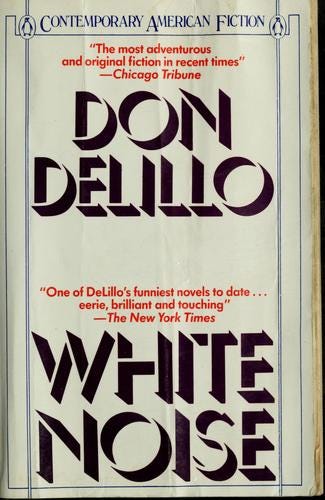Here's a little thing about "Aboutism" while contemplating White Noise (1985), the novel, the film (2022), the strange real-life echo unfolding in Ohio.
Not whataboutism, which I unfortunately Googled and discovered its roots in Soviet fuckery. Not Aboutness (2014), which a Google search led rewardingly to a philosophy book of apparent brilliance.
No, my use of Aboutism is wholly my own.
What is it? A dictionary definition might read something like this: "The limiting of a discussion of a narrative-based work of art to its plot. As in, 'Don Delillo's novel White Noise is about an airborne toxic event.'"
Of course it's not.
Yet, the other day I encountered a Tweet saying the people in Ohio were living through an airborne toxic event after having served as extras in a movie about an airborne toxic event. The movie was the recent Netflix production based on the Delillo novel about, well, you get it. CNN covered the overlap.
Here's my point. Just because an airborne toxic event happens in White Noise doesn't mean White Noise is about an airborne toxic event. In fact, the definition of a literary work is that it can't be reduced to plot summary. Its aboutness is contested. The more contested, maybe, the better. Perhaps it's even an improvement to say, literary analysis must be more than plot summary.
Plot summary ain’t literary analysis.
In his introduction to the Viking Critical Library (1998) edition of White Noise, editor Mark Osteen shows where some analysis of Delillo’s novel has gone:
With the rise of cultural studies in the academy, many literary critics diverted their attention to the very arenas — TV, advertising, pop culture — depicted by White Noise, applying theories such as those propounded by French cultural theorist Jean Baudrillard. In his highly influential book Simulations, Baudrillard argues that original ideas and events have now been replaced by simulacra — an infinite regress of reproductions without origins; in turn, the "real" has given way to what he called the "hyperreal" (Baudrillard 1988, 166), John Frow was the first to elucidate the connection between White Noise and Baudrillardian simulacra, arguing that the replacement of originals by simulations has worked both to pervert and preserve American myths of origins and authenticity (xiii).
The 2022 Netflix version of White Noise is full-on with the Baudrillardian approach. Director Noah Baumbach (also the screenwriter) highlights the instability of Delillo's world, before, during, and after the irrefutable fact of the airborne toxic event. Witness, for example, the shifting language to describe the disaster, as the characters shift their understanding of the risk they're under. One new definition follows another, until action is required. Evacuate!
And now we have the real thing, not a simulation. A real toxic cloud in Ohio, and a similar search for definition. Art/Life. Life/Art. Talk about hyperreal, man.
I've watched White Noise, the film, twice. I will admit that the first time, my focus was on the plot and the comic tone was unsettling. A lot happens in this story, and yet a lot of the time you're not sure what's going on. Then language itself fragments — the connections between words and things falls apart.
The second time I watched it, I paid more attention to the language theme. It's persistent throughout, and I commend Baumbach for capturing Delillo's linguistic twists while in the process of converting the words to images.
Conclusion: Amazing.
What’s it about? The mystery of signifiers, or something like that. I mean, who cares?
It’s fun. Deep fun.


